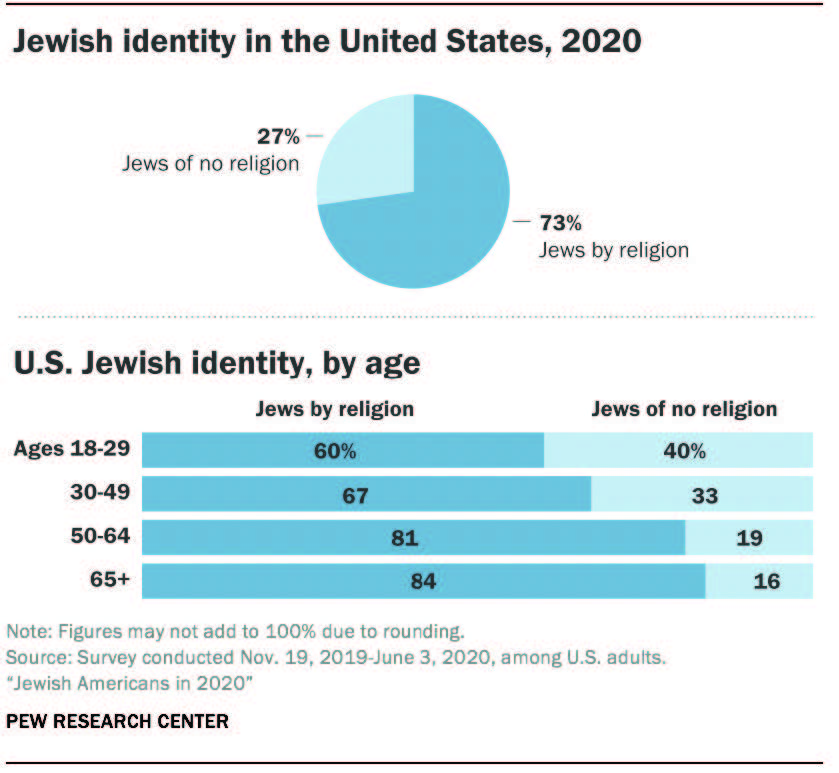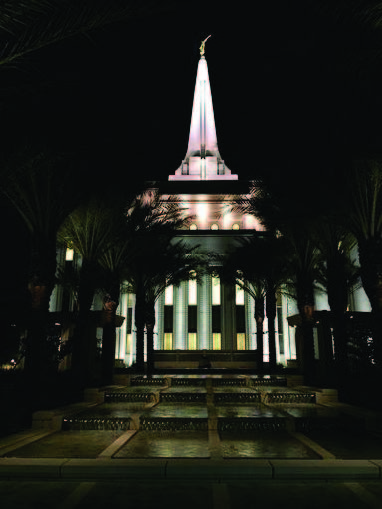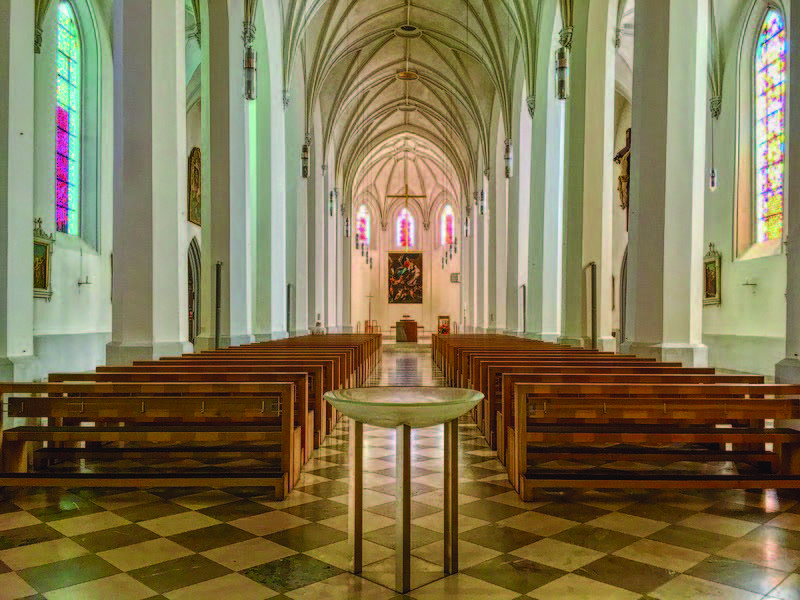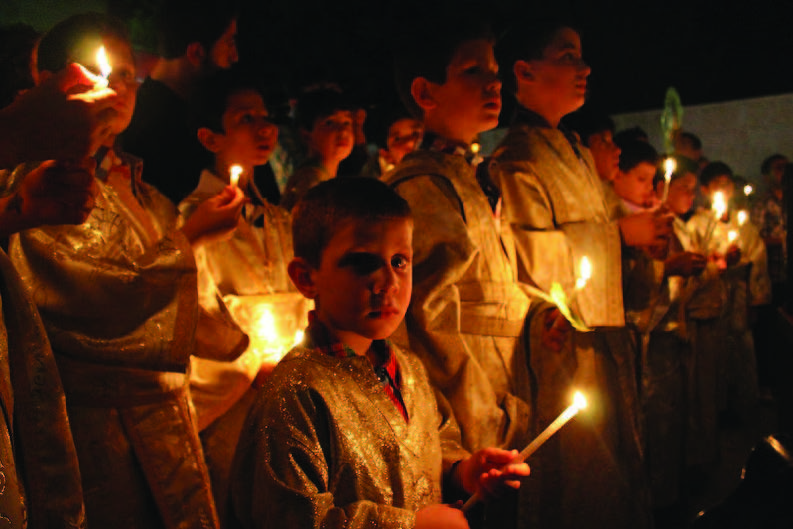
![]() A new survey of U.S. Jews finds that, while holding their own numerically, they are increasingly split between secularism and Orthodoxy, especially among the youngest
A new survey of U.S. Jews finds that, while holding their own numerically, they are increasingly split between secularism and Orthodoxy, especially among the youngest  adults. The survey by the Pew Research Center is a follow-up to its landmark 2013 study. American Jews are keeping up with the wider population, increasing to 7.5 million adults and children from 6.7 million eight years ago. The new study finds, however, that while nearly three-quarters of Jews identify as Jewish by religion, a growing number—27 percent—do not consider themselves as religious, identifying instead as Jewish ethnically, culturally, or by ancestry. This group of Jewish secularists is particularly large among those between the ages of 18 to 29, where fully 40 percent consider themselves Jewish without religion. And although Orthodox Jews represent 9 percent of the overall American Jewish population, they were found to represent 17 percent within the 18-to-29 age group. A little more than half of U.S. Jews identify with the Reform or Conservative movements.
adults. The survey by the Pew Research Center is a follow-up to its landmark 2013 study. American Jews are keeping up with the wider population, increasing to 7.5 million adults and children from 6.7 million eight years ago. The new study finds, however, that while nearly three-quarters of Jews identify as Jewish by religion, a growing number—27 percent—do not consider themselves as religious, identifying instead as Jewish ethnically, culturally, or by ancestry. This group of Jewish secularists is particularly large among those between the ages of 18 to 29, where fully 40 percent consider themselves Jewish without religion. And although Orthodox Jews represent 9 percent of the overall American Jewish population, they were found to represent 17 percent within the 18-to-29 age group. A little more than half of U.S. Jews identify with the Reform or Conservative movements.
The Orthodox-secularist rift plays out in politics. Seven-in-ten Jewish adults identify with or lean toward the Democratic Party, and half describe their political orientation as liberal. The Orthodox are almost the reverse, with 60 percent describing their political views as conservative, and 75 percent claiming to be Republican. While age appears to be the dividing line between religious and secular Jews, the Pew survey also suggests that religious intermarriage may be a factor in the growing gap. While a large majority (68 percent) of “Jews by religion” have Jewish spouses, an even larger majority (79 percent) of “Jews of no religion” have non-Jewish spouses.
(The Pew study can be downloaded from: https://www.pewforum.org/2021/05/11/jewishamericans- in-2020/)
![]()

Source: Chuck Gray | Pixabay
Despite a plateauing of growth, the Church of Jesus Christ of Latter-day Saints (LDS) is continuing to build new temples. In her blog Flunking Sainthood (May 20), Jana Reiss notes that the church recently announced the building of 20 new temples around the world, which according to the LDS Church Growth website will bring the total number of Mormon temples to 252. Seventy of these have been announced in just the three and half years that President Russell Despite a plateauing of growth, the Church of Jesus Christ of Latter-day Saints (LDS) is continuing to build new temples. In her blog Flunking Sainthood (May 20), Jana Reiss notes that the church recently announced the building of 20 new temples around the world, which according to the LDS Church Growth website will bring the total number of Mormon temples to 252. Seventy of these have been announced in just the three and half years that President Russell Nelson has led the church. Apart from a slight uptick in 2019, there has been a steady decline in new members, both in terms of converts and “children of record.” Although the 2020 numbers have not been released yet and are likely to be skewed by the pandemic, even the pre-Covid trajectory of growth—between 1 to 2 percent a year—was not so high that it would call for the 28 percent increase in. planned temples. Additionally, some of these temples are planned for no-growth areas, such as Norway, Belgium, and Austria. Reiss concludes that “[i]f yesterday’s temple was a prize bestowed on area members when they had achieved certain milestones related to growth, today’s temple is a jumper cable, a tool to re-energize the sputtering engine of the church’s numerical growth. Each announced temple represents our hope that positive community interest today could translate into converts tomorrow: ‘If you build it, they will come.’”
![]()
One of the first large studies of the political involvement of pagans in the U.S. finds that they are “true” independents as far as their voting preferences and political ideology, but are engaged in politics in their own way. The study, conducted by Kathleen  Marchetti of Dickinson College and published in the journal Politics and Religion (online in May), is based on an analysis of data from the 2014 Pew Religious Landscape Survey. Marchetti found that pagans trend toward moderate to left viewpoints and vote with Democrats more than non-pagans do, but they also have lower rates of voting than non-pagans. And they are also more likely to identify as true political independents, with some voting for third-party candidates, such as from the Green and Libertarian parties. Support for LGBTQ protections is what Marchetti calls a “unified measure of pagan religious identity,” though there is less uniform acceptance of transgender identities in some sectors of the pagan community.
Marchetti of Dickinson College and published in the journal Politics and Religion (online in May), is based on an analysis of data from the 2014 Pew Religious Landscape Survey. Marchetti found that pagans trend toward moderate to left viewpoints and vote with Democrats more than non-pagans do, but they also have lower rates of voting than non-pagans. And they are also more likely to identify as true political independents, with some voting for third-party candidates, such as from the Green and Libertarian parties. Support for LGBTQ protections is what Marchetti calls a “unified measure of pagan religious identity,” though there is less uniform acceptance of transgender identities in some sectors of the pagan community.
As might be expected, environmentalism is also a shared political ideal. But aside from these two issues, pagans were found to be relatively diverse. Although the pagan community is “women-dominated,” with some pagan religions being goddess-centered, they “hold no distinctive views on women in the workforce,” Marchetti said, and men actually hold a disproportionate number of positions of authority within pagan organizations. With a large majority of the pagan community being white, pagans exhibit no strong feelings as a group about immigration.
(Politics and Religion, https://www.cambridge.org/core/journals/politics-and-religion)
![]()
Sexual abuse scandals in the Catholic Church in Germany have contributed to increased. rates of exit from the church and have even had a spillover effect on Protestant churches, according to a new study. In an article appearing in the Journal for the Scientific Study of Religion (online in May), Bernd Frick, Rob Simmons, and Katharina Moser look at diocese-level data for church exits and how they tend to be nonlinear and to peak at certain times. Exiting churches is a formal procedure in Germany, where one can opt-out of paying taxes that go to supporting the churches. It was only in 2010 that records of clerical abuse became public in the country, with 3,677 cases reported between 1946 and 2014. Several financial scandals in the German Catholic churches have also been made public since 2014. Both kinds of scandal are seen as “exogenous shocks” that can have an effect on religious participation, and the. researchers did find that the recent sex abuse scandals had “significantly negative immediate and long-term impact, in the sense that they increased the annual exits from the Catholic Church. Sexual abuse scandals in the Catholic Church also raised exit rates in the Protestant Church with a delay.” However, they found “zero effects of the financial scandals on exits from the Catholic Church while there [were] positive impacts from these scandals on exits from the Protestant Church.”
(Journal for the Scientific Study of Religion, https://onlinelibrary.wiley.com/journal/14685906)

![]()
A new study finds that switching across denominational lines among Palestinian Christians is increasingly practiced in Palestine. In the study, published in the journal Exchange (50), Mari Parkkinen conducted in-depth interviews with 35 Palestinian Christians from mainline and evangelical Protestant, Catholic, and Orthodox communities. She found that women and young adults were the most mobile between denominations. One-fifth of her respondents had switched their denomination entirely, about one-third had more than one affiliation, and a little less than half (46 percent) had a stable affiliation. The most common motivation for switching was personal belief, followed by marrying a partner of a different denomination. Christians are a relatively small community in Palestine, with about 50,000 adherents, and the high rate of denominational mobility could be due to the common incidence of ecumenical marriages and social interaction. But Parkkinen concludes that this pattern could also be the result of a more individualistic approach, where family and community traditions are less important.
(Exchange, https://brill.com/view/journals/exch/exch-overview.xml)

Palestinian Christians welcome Easter to Gaza (source: Joe Catron, 2013 | Flickr).